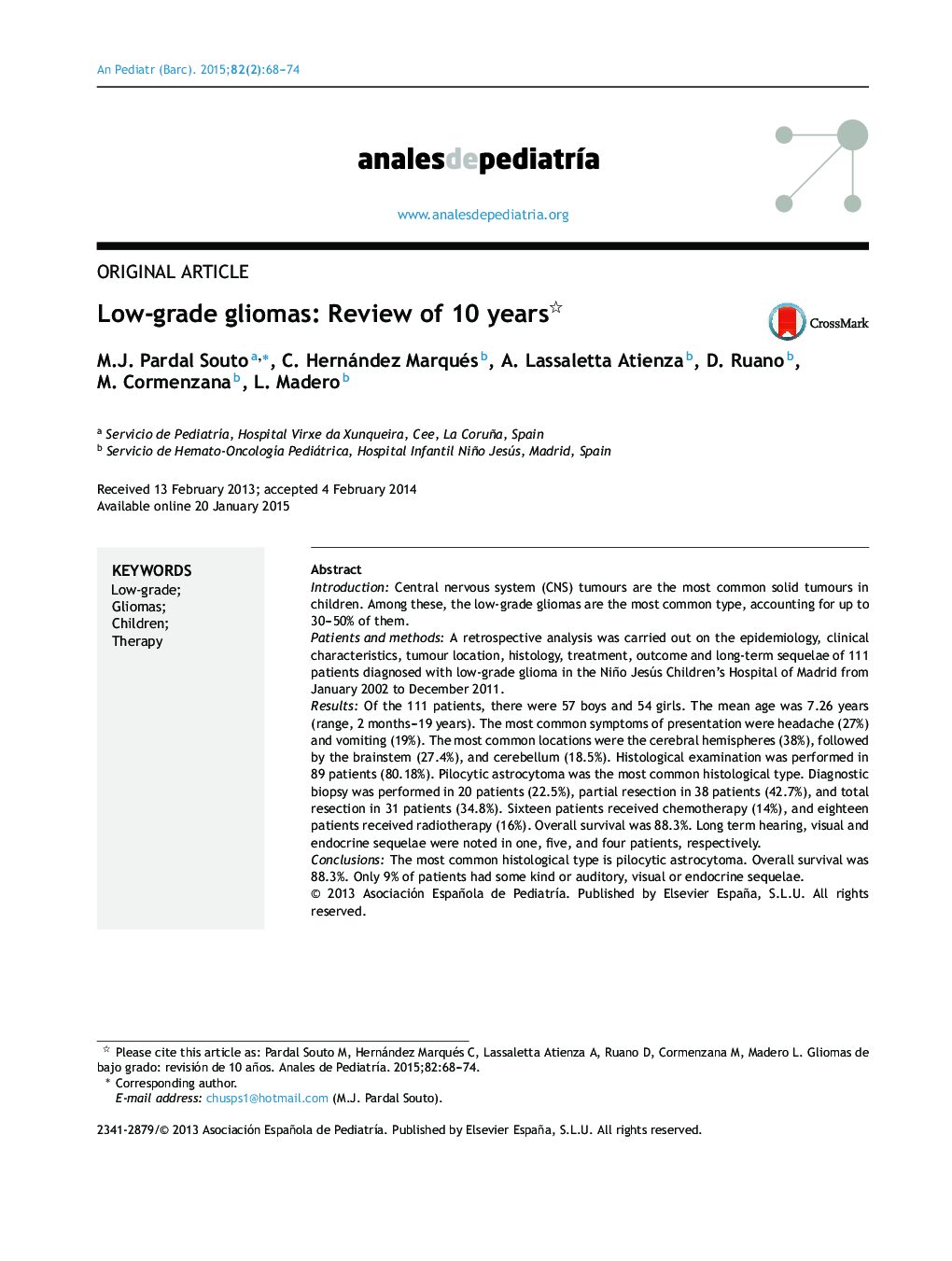| کد مقاله | کد نشریه | سال انتشار | مقاله انگلیسی | نسخه تمام متن |
|---|---|---|---|---|
| 4145278 | 1272599 | 2015 | 7 صفحه PDF | دانلود رایگان |
IntroductionCentral nervous system (CNS) tumours are the most common solid tumours in children. Among these, the low-grade gliomas are the most common type, accounting for up to 30–50% of them.Patients and methodsA retrospective analysis was carried out on the epidemiology, clinical characteristics, tumour location, histology, treatment, outcome and long-term sequelae of 111 patients diagnosed with low-grade glioma in the Niño Jesús Children's Hospital of Madrid from January 2002 to December 2011.ResultsOf the 111 patients, there were 57 boys and 54 girls. The mean age was 7.26 years (range, 2 months–19 years). The most common symptoms of presentation were headache (27%) and vomiting (19%). The most common locations were the cerebral hemispheres (38%), followed by the brainstem (27.4%), and cerebellum (18.5%). Histological examination was performed in 89 patients (80.18%). Pilocytic astrocytoma was the most common histological type. Diagnostic biopsy was performed in 20 patients (22.5%), partial resection in 38 patients (42.7%), and total resection in 31 patients (34.8%). Sixteen patients received chemotherapy (14%), and eighteen patients received radiotherapy (16%). Overall survival was 88.3%. Long term hearing, visual and endocrine sequelae were noted in one, five, and four patients, respectively.ConclusionsThe most common histological type is pilocytic astrocytoma. Overall survival was 88.3%. Only 9% of patients had some kind or auditory, visual or endocrine sequelae.
ResumenIntroducciónLos tumores del SNC son los tumores sólidos más frecuentes en la edad pediátrica. Dentro de ellos los gliomas de bajo grado constituyen el tipo más común de tumour del SNC en niños, representando hasta el 30–50% de los mismos.Pacientes y métodosAnálisis retrospectivo de las características epidemiológicas, manifestaciones clínicas, localización del tumour, histología, tipo de tratamiento si lo ha recibido, evolución y secuelas a largo plazo de 111 pacientes diagnosticados de glioma de bajo grado en el Hospital Infantil Universitario Niño Jesús de Madrid entre enero de 2002 y diciembre de 2011.ResultadosDe los 111 pacientes 57 eran niños y 54 niñas. La edad media fue de 7,26 años (intervalo 2 meses-19 años). Los síntomas de presentación más frecuentes fueron la cefalea (27%) y los vómitos (19%). Las localizaciones más frecuentes fueron los hemisferios cerebrales (38%), seguido del tronco cerebral (27,4%) y del cerebelo (18,5%). Se realizó estudio histológico en 89 pacientes (80,18%), siendo el astrocitoma pilocítico el tipo histológico más frecuente. Se realizó biopsia diagnóstica en 20 pacientes (22,5%), resección parcial en 38 pacientes (42,7%) y resección total en 31 pacientes (34,8%). Recibieron quimioterapia 16 pacientes (14%) y radioterapia 18 pacientes (16%). La supervivencia global fue del 88,3%. Un paciente presentó secuelas auditivas, 5 pacientes presentaron secuelas visuales y 4 pacientes secuelas endocrinas.ConclusionesEl tipo histológico más frecuente es el astrocitoma pilocítico. La supervivencia global fue del 88,3%. Solo el 9% de los pacientes presentaron algún tipo de secuela auditiva, visual o endocrinológica.
Journal: Anales de Pediatría (English Edition) - Volume 82, Issue 2, February 2015, Pages 68–74
